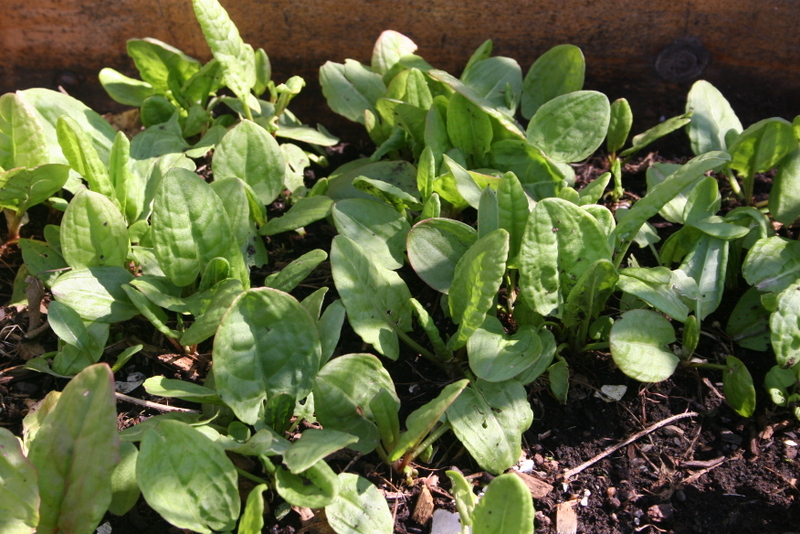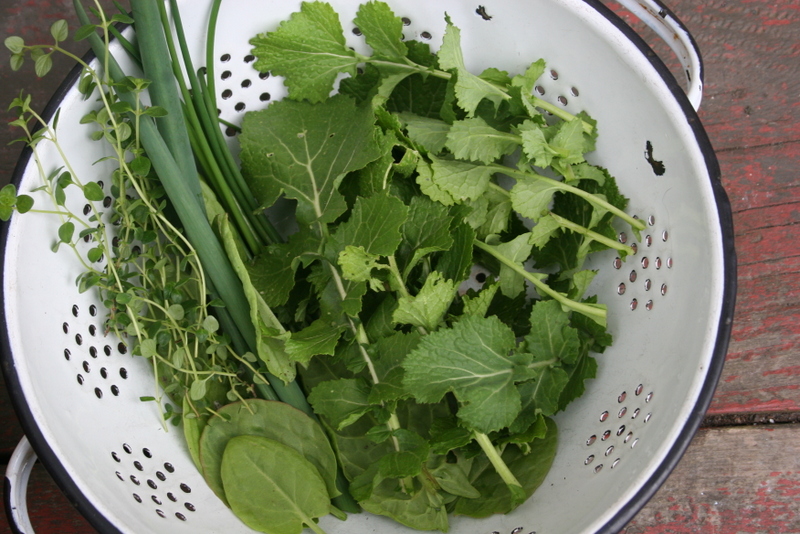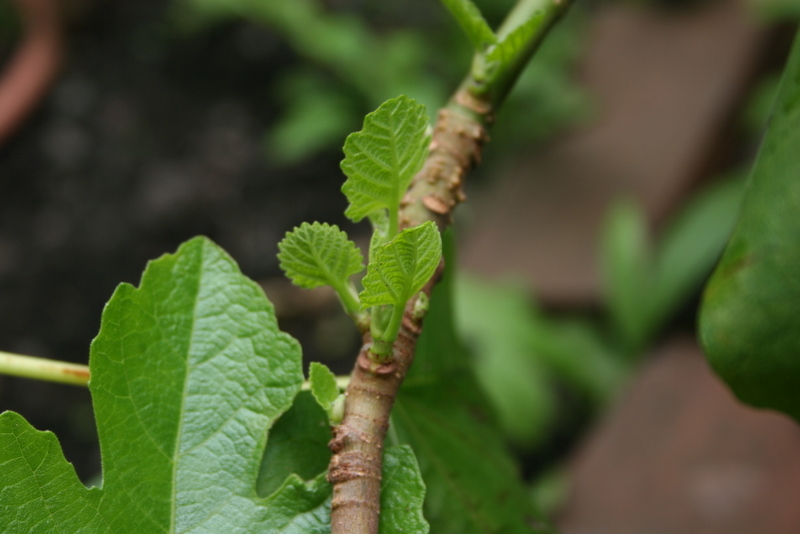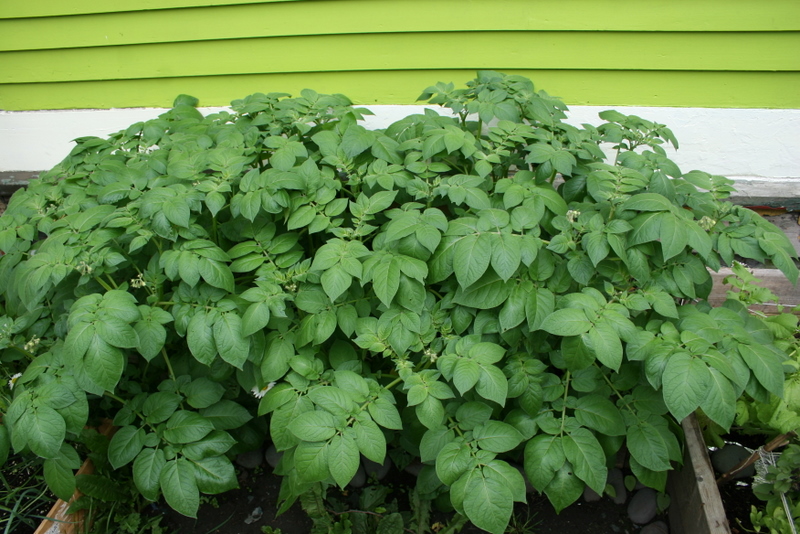These two new farmers have been operating Roots Country Farm near Bay Roberts for two seasons now.
Lazy in the fall, happy in the spring
Last weekend, I had the extreme good pleasure to attend a workshop on extending your growing season. The workshop facilitator was Dan Rubin, a home vegetable gardener who, through tactical use of raised beds, glass panes, and plastic row covers, has grown a whole lot of impressive eats in a location which is, essentially, a salt-lashed, wind-beaten, topsoil-less bit of rock (and I say that with love - I was born there and I adore the place). As the workshop participants wandered Dan's garden, and the garden at Points East Bed and Breakfast next door, we identified the plants which, despite having been left outside for the harsh coastal winter, were doing just fine: kale, huge leeks, sorrel, thyme, Egyptian onions... perhaps not looking quite as lush as they had been in October, but still mighty impressive.
Now, my own garden is also bursting with vegetables that survived the winter, however, in my case, most of the veggies are still there because I did such a miserable job of tidying the garden last year. Because really, aside from putting in a new batch of garlic, I didn't do a thing. Even the garlic I managed to mess up - I don't think I got around to planting it until January some time, so if I get decent heads it will be against all odds (and purely down to my excessive application of compost and prayer... and I'm an atheist, so it's really about the compost...).
I've been picking at the sorrel and the chives for a little bit now, and I ate what was left of the droopy kale. The oregano popped up, and my husband and I were compelled to fire up the grill for our inaugural spring "souvlaki plate" dinner.
And then I found something I hadn't anticipated. In the very messy bed in the front yard, there was this weedy-looking thing that had remained green under all the snow (and under the Christmas tree that we had stylishly discarded on top of it). I didn't give the weedy thing much thought, because I couldn't remember what I had planted there. But then it struck me: arugula! Survivor arugula! Survivorugula!
Sure enough, the weedy-looking stuff was the arugula that I had planted last year and which, in the terrible weather we had, didn't make much of an appearance at all. Here it had been, silently waiting out the cold, and then bursting into leaf as soon as the snow melted. It was tender, sweet, and possibly the most delicious arugula I have ever eaten.
I harvested a bunch of it, along with some sorrel, chives, Egyptian onions, and some lemon thyme (a little leggy from spending the winter in the kitchen window, but still tasty). Then I boiled some new potatoes until they were tender, while sauteeing my harvest with some of the last summer garlic. When the potatoes were done and the greens just wilted, I tossed it all together.
A meal fit for royalty, I tell you!
Since then, I have picked at the arugula a little more - I used some for greens in our burgers last night (along with some fresh herb mayo that I whipped together using some more of the chives and lemon thyme, with a generous grinding of black pepper). It won't last long, I'm sure; apparently overwintered arugula bolts at the slightest provocation. That's okay, though, because I have more arugula coming up in the cold frame to take the place of this stuff. I don't think it could possibly be as lovely, though.
This fall, I will definitely make sure I have some arugula overwintering somewhere in the garden. And I'll write down where I put it, too, so I don't end up wasting precious days asking, "What the heck kind of weedy thing is that?"
My front yard grocery store
When you garden in the city, you take your sunshine where you can find it. I have a tiny postage-stamp of a front yard, and a decent-sized back yard (for downtown). Neither one of them gets full sunlight, but from mid-June on the front yard gets blazing, baking afternoon light that vegetables seem to love. I had forgotten this when I started my garden this summer. Slowly but surely, though, I've been migrating pots and containers to the front of the yard, where they flourish, and scratching my head as I wonder about the best use for my backyard space.
Some of you may have heard the story this summer of a Michigan woman who was threatened with jail time for having replaced her front lawn with raised vegetable beds. In the end the charges were dropped, but things like this happen from time to time in the suburbs and in gated communities. In my 'hood, though, I think people are happy just to see something other than cars up on blocks, rampant sticky-buds, and abandoned, rusting home appliances.
Now, my front yard isn't going to win any beauty contests. The fence needs painting, the gate is broken, and there's a mud-pit where there once was grass. Still, people smile when they walk past, and they often stop to ask me what I'm growing. There's always some amazement when I rattle off my "grocery list": potatoes, chard, snow peas, garlic, radishes, tomatoes, fava beans, herbs, edible flowers, carrots, leeks, arugula, and some struggling squash plants... ground cherries... strawberries... did I leave anything out?
For a seasoned vegetable grower, it's easy to tell that I'm harbouring dinner among the pansies, cosmos, nasturtiums, and poppies in front of my house, but to the average passer-by, it all just looks like greenery. And I like it this way. Not that I object to front yards looking like mini-farms - I'm all for growing your veggies in any way that suits your schedule, your aesthetic, and your available growing space. But there's something fun about being able to sneak your edibles past everyone, and I love the way people react when they realize I have the makings of many meals just outside my front door.
There are a lot of inspiring books and websites about edible landscaping (aka "making your veggie garden look super pretty"). British gardening show host Alys Fowler's books, The Edible Garden and Garden Anywhere are both really fantastic (and her climate is similar to ours). Rosalind Creasy is the guru of ornamental edible gardening, and her book, Edible Landscaping, has just been re-released (it's excellent). Ivette Soler's The Edible Front Yard is a new book with lots of great ideas for creating a beautiful garden design with your fruits and veggies.
Of course, no matter what your vegetable garden looks like, it's all about what's coming out of it, and on to your plate. How about some delicious new potatoes? I cooked these ones up with chard, beet tops, and chives, and the next harvest got cooked and tossed with fava beans and dill (and doused with butter and lemon juice). Better than any store, that's for sure!
Downtown Dirt end-of-July update
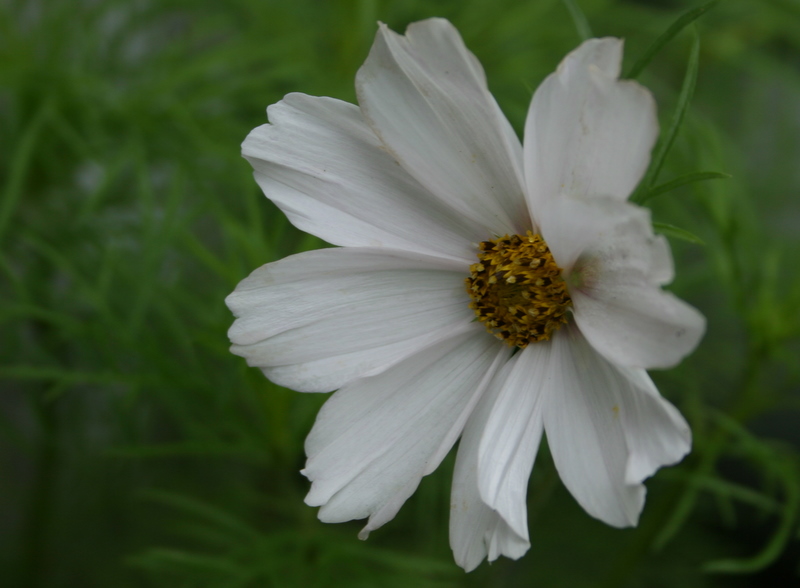 Hello, friends! I had wanted to do a lovely pictorial of all the things growing happily in my garden today, but unfortunately almost everything in the back yard is completely covered in specks of black poo from the millions of tiny worms rolled up in the leaves of my neighbours' enormously large maple tree, the branches of which now reach almost 2/3 of the way across my back yard. It's to the north of my garden, so it doesn't block all the light (although if it weren't there, I could grow super sunny crops like corn and peppers without any trouble, I'm pretty sure), but it does shower everyone and everything with worm poo for weeks of the summer, then with seeds which seem to have a 115% germination rate, and which I spend the entire warm season trying to remove. Ah, but it is a lovely tree, I suppose. A lovely, wormy, shady, seedy tree. (The neighbours, though, really are lovely, and since they're renters I do not hold the pooping monster tree against them. We're all victims here!)
Hello, friends! I had wanted to do a lovely pictorial of all the things growing happily in my garden today, but unfortunately almost everything in the back yard is completely covered in specks of black poo from the millions of tiny worms rolled up in the leaves of my neighbours' enormously large maple tree, the branches of which now reach almost 2/3 of the way across my back yard. It's to the north of my garden, so it doesn't block all the light (although if it weren't there, I could grow super sunny crops like corn and peppers without any trouble, I'm pretty sure), but it does shower everyone and everything with worm poo for weeks of the summer, then with seeds which seem to have a 115% germination rate, and which I spend the entire warm season trying to remove. Ah, but it is a lovely tree, I suppose. A lovely, wormy, shady, seedy tree. (The neighbours, though, really are lovely, and since they're renters I do not hold the pooping monster tree against them. We're all victims here!)
So yes, all my backyard plants are covered in worm poo and not looking all that pretty. They're doing reasonably well, though. My Jerusalem artichokes, which were nearly devoured by slugs, are now about two and a half feet high and have formed a thick stand behind one of my raised beds and against the neighbours' fence (directly in the line of fire of the most worm poo). When I ordered them, I knew where I wanted to put them, but I wasn't sure exactly how to execute it. I didn't want to put them straight in the ground, because they're in the sunflower family, and sunflowers suck lead out of the soil - great if you're growing ornamental sunflowers and then binning them, but not so great if you're growing them for their tasty tubers. Time was running short and I hadn't come up with a good plan, so I just flung a bag of soil on its side, cut the now-top of the plastic off, and planted them in there. They're definitely too close for comfort, and probably won't produce all that well due to cramped space, but seeing as how there's no proof that anyone but me even likes Jerusalem artichokes, I think that's alright.
Across the yard, away from the worm poo (but straight into the bindweed), my fig is putting out tons of new growth.
My fig lives in an old enamel stock pot with holes in the bottom. This year, I gave it new soil and fed it with tomato feed, which is apparently something figs like (according to someone on the web somewhere - I can't for the life of me remember). I had overwintered it indoors last year, but I think this year I'll tuck it in a protected corner of my patio and let it experience the winter. I think I've interrupted its natural cycle of dormancy by keeping it too warm, and now the poor thing is confused. If I ever want to eat a fig from my own tree, I'd best try to un-confuse it.
Right now, the most advanced crops are my tomatoes, which are all beginning to flower, and my Onaway potatoes, which are looking fantastic (and taking up half my front yard).
Their leaves are so lush and gorgeous! Since Onaways are "earlies," I can start feeling around for baby potatoes as soon as the flowers do their thing. I'm super excited, especially after last year's great potato failure. These guys don't make great storage potatoes, from what I hear, but I have Pink Fir Apple spuds growing out back for that. They went in the ground much later, so they're nowhere near as advanced, but I think they'll do alright.
Out of the crops I didn't expect to do all that well, my Aunt Molly's ground cherry seems to be coming along quite marvelously. I have one in a pot in my front yard that is going great guns, and another two in a raised bed in the back yard that are quickly catching up. I put in three more plants at my mother's house, but they're not quite so happy, for reasons we have yet to determine. I'm super excited about these. I used to eat ground cherries until I couldn't take it any more when I lived in Montreal, but they're pretty scarce around here. They really are very tasty.
So that's the good news. Sadly, it's not all looking that good. My cucumbers never came up at all. I sowed them outdoors under glass because I ran out of space under the grow lights in my basement, but nothing happened. My Gnadenfeld melon plants were eaten by slugs, and I think my Blacktail Mountain watermelon might suffer the same fate. I have plenty of seeds left of each to try again next year, but still, it's pretty disappointing. My French beans never came up at all, and I had wanted to train them up a nice, attractive teepee, with sweet peas growing up among them. Well, at least the sweet peas are growing, so the teepee won't look totally stupid.
Oh, and my brassicas at my mother's place are full of cabbage worms. We broke out the BT and are hoping for the best. Now, if only the landlords next door would come spray that tree...








